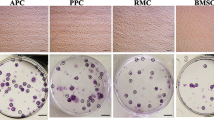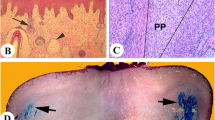Abstract
Epimorphic regeneration is the “holy grail” of regenerative medicine. Research aimed at investigating the various models of epimorphic regeneration is essential if a fundamental understanding of the factors underpinning this process are to be established. Deer antlers are the only mammalian appendages that are subject to an annual cycle of epimorphic regeneration. In our previous studies, we have reported that histogenesis of antler regeneration relies on cells resident within the pedicle periosteum (PP). The present study elaborates this finding by means of functional studies involving the deletion of PP. Four yearling and four 2-year-old stags were selected for total PP deletion or partial PP deletion experiments. Of the animals in the total PP deletion group, one showed no signs of antler regeneration throughout the antler growth season. Two showed substantial and one showed marginal delays in antler regeneration (at 34, 20 and 7 days, respectively) compared with the corresponding sham-operated sides. Histological investigation revealed that the delayed antlers were derived from regenerated PP. Unexpectedly, the regenerative capacity of the antler from the total periosteum-deleted pedicles depended on antler length at surgery. Of the four deer that had partial PP deletion, two regenerated antlers exclusively from the left-over PP on the pedicle shafts in the absence of participation from the pedicle bone proper. The combined results from the PP deletion experiments convincingly demonstrate that the cells of the PP are responsible for antler regeneration.







Similar content being viewed by others
References
Bubenik AB, Pavlansky R (1956) Von welchem Gewebe geht der eigentliche Reiz zur Geweihbildung aus? II. Mitteilung: Operative Eingriffe auf den Rosenstöcken der Rehbocke, Capreolus capreolus (L., 1758). Säugetierkundliche Mitteilungen 4:97–103
Gargioli C, Slack JM (2004) Cell lineage tracing during Xenopus tail regeneration. Development 131:2669–2679
Goss RJ (1961) Experimental investigations of morphogenesis in the growing antler. J Embryol Exp Morph 9:342–354
Goss RJ (1983) Deer antlers. Regeneration, function and evolution. Academic Press, New York
Goss RJ (1995) Future directions in antler research. Anat Rec 241:291–302
Hartwig H, Schrudde J (1974) Experimentelle Untersuchungen zur Bildung der primären Stirnauswüchse beim Reh (Capreolus capreolus L.). Z Jagdwiss 20:1–13
Jaczewski Z (1955) Regeneration of antlers in red deer, Cervus elaphus L. Bull Acad Pol Sci (II) Sci Biol 3:273–278
Johnson P, Fromm D (1981) Effects of bone wax on bacterial clearance. Surgery 89:206–209
Kierdorf U, Stoffels E, Stoffels D, Kierdorf H, Szuwart T, Clemen G (2003) Histological studies of bone formation during pedicle restoration and early antler regeneration in roe deer and fallow deer. Anat Rec 273A:741–751
Li C (2003) Development of deer antler model for biomedical research. Recent Adv Res Updat 4:256–274
Li C, Suttie JM (1994) Light microscopic studies of pedicle and early first antler development in red deer (Cervus elaphus). Anat Rec 239:198–215
Li C, Clark DE, Lord EA, Stanton JA, Suttie JM (2002) Sampling technique to discriminate the different tissue layers of growing antler tips for gene discovery. Anat Rec 268:125–130
Li C, Suttie JM, Clark DE (2004) Morphological observation of antler regeneration in red deer (Cervus elaphus). J Morphol 262:731–740
Li C, Suttie JM, Clark DE (2005a) Histological examination of antler regeneration in red deer (Cervus elaphus). Anat Rec [A] Discov Mol Cell Evol Biol 282A:163–174
Li C, Suttie JM, Clark DE (2005b) Deer antler regeneration: a system which allows the full regeneration of mammalian appendages. In: Suttie JM, Haines SR, Li C (ed) Advances in antler science and product technology. Queenstown, New Zealand, pp 1–10
Li C, Yang F, Li G, Gao X, Wei H, Deng X, Clark DE (2006) Antler regeneration: a dependent process of stem tissue primed via interaction with its enveloping skin. J Exp Zool (in press)
Mescher A (1996) The cellular basis of limb regeneration in urodeles. Int J Dev Biol 40:785–795
Price JS, Allen S, Faucheux C, Althnaian T, Mount JG (2005) Deer antlers: a zoological curiosity or the key to understanding organ regeneration in mammals? J Anat 207:603–618
Stocum DL (2004) Regenerative biology and medicine: an overview. Cell Sci 1:1–19
Stocum DL, Maden M (1990) Regenerating limbs. Methods Enzymol 190:189–201
Tsonis PA (2002) Regenerative biology: the emerging field of tissue repair and restoration. Differentiation 70:397–409
Wallace H (1981) Vertebrate limb regeneration. Wiley, Chichester
Acknowledgements
The authors are grateful to Mr. Martin and the deer crew for assistance in the handling and care of the experimental deer and to Ms. Marion Labes for preparing the histological slides.
Author information
Authors and Affiliations
Corresponding author
Additional information
The authors thank the New Zealand Foundation of Research, Science and Technology and Deer Industry New Zealand for funding their research.
Rights and permissions
About this article
Cite this article
Li, C., Mackintosh, C.G., Martin, S.K. et al. Identification of key tissue type for antler regeneration through pedicle periosteum deletion. Cell Tissue Res 328, 65–75 (2007). https://doi.org/10.1007/s00441-006-0333-y
Received:
Accepted:
Published:
Issue Date:
DOI: https://doi.org/10.1007/s00441-006-0333-y




